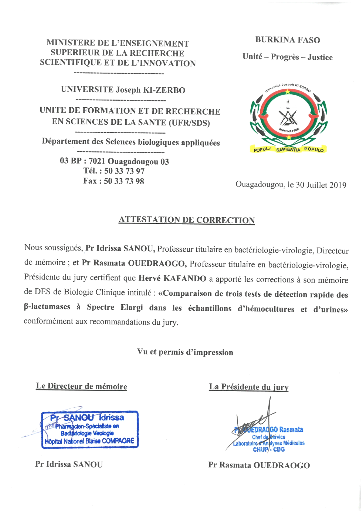RESUME
Les entérobactéries sont les principaux germes
responsables de bactériémies et d'infections du tractus urinaire.
Ces bactéries sont devenues une menace mondiale du fait de leurs
multirésistances aux antibiotiques, essentiellement due à
l'acquisition de â-lactamases à spectre élargi. Le but de
ce travail est d'évaluer d'une part, les performances diagnostiques de
l'automate ePlex® dans l'identification des bacilles à Gram
négatif et les gènes de résistances associés et
d'autres part évaluer les performances du NG-Test-CTXM MULTI et
â-LACTATMtest dans la détection des BLSE à
partir des échantillons d'urines et d'hémocultures.
Sur une période de cinq mois, les automates ePlex®
et MALDI-TOF-MS ont été utilisés pour l'identification des
bactéries à partir des échantillons d'hémocultures
et d'urines positives à bacilles à Gram négatif à
l'examen microscopique. La détection des BLSE a été
réalisée par l'automate ePlex® et par les NG-Test-CTXM MULTI
et â-LACTATM Test.
Au total, 53 échantillons d'urines et
52 hémocultures ont été analysés, les
entérobactéries représentaient respectivement 93 % (52/56)
et 59 % (33/56) des identifications avec Escherichia coli en
tête, 66 % (37/56) et 37,5 % (21/56) dans les ITU et les
bactériémies. Les entérobactéries productrices de
BLSE étaient de 21,2 % (11/52) dans les ITU et 27,3% (9/33) dans les
bactériémies.Les concordances d'identification entre ePlex®
et MALDI-TOF-MS après isolement étaient d'environ 95 % dans les
deux types d'échantillons. Les performances diagnostiques de l'automate
ePlex® pour la détection des BLSE sont similaires à celles
du â-LACTATM test avec des sensibilités de 81,8
à 100 % et des spécificités de 95 à 100%. Le
NG-Test-CTX-M MULTI a montré de meilleurs résultats avec des
sensibilités allant de 90,9 à 100 % et des
spécificités de 97,6 à 100 %. Le panel Gram négatif
de ePlex® est bien adapté au diagnostic rapide des
entérobactéries et la mise en évidence des gènes de
résistance associés. Toutefois, la simplicité et le
moindre coût des tests â-LACTATMainsi que des
NG-Test-CTX-M MULTI font d'eux des alternatives efficaces dans le diagnostic
rapide des entérobactéries productrices de BLSE.
Mots clés :BLSE, CTXM,
â-LACTAtest, ePlex®.
ABSTRACT
Enterobacteria are the main germs responsible for
bloodstreams and urinary tract infections. These bacteria became a global
threat because of their multidrug resistance, essentially due to the Extended
Spectrum Betalactamase (ESBL) acquisition. The purpose of this study is to
evaluate on the one hand, the diagnostic performances of the ePlex® PLC
from urines and blood cultures samples for Gram negative bacilli (BGN) and
associated resistances genes identification and, on the other hand, to evaluate
the performance of NG-Test-CTXM MULTI and â-LACTATM test in
the detection of ESBL from urine and blood cultures samples.
During five months, an identification has been achieved by
ePlex® and by MALDI-TOF-MS, from the positive urines and blood cultures
with BGN to the microscopic exam. The detection of the ESBL has been achieved
by ePlex®, NG-Test-CTXM MULTI and â-LACTATM Test.
On 53 samples of urines and 52 blood cultures analyzed, the
enterobacteria represented 93 % (52/56) and 59 % (33/56) respectively, with 66
% (37/56) and 37,5 % (21/56) of E. coli in UTI and bacteremia.
ESBL-producing enterobacteria were 21.2% (11/52) in the UTI and 27.3%
(9/33) in the bacteremia. The corresponding identification between ePlex®
and MALDI-TOF-MS were approximately 95 % in both types of samples.
The diagnostics performances of the ePlex® PLC for ESBL
production are similar to that of the â-LACTATM test with
sensitivities of 81.8 to 100% and specificities of 95 to 100%. The
NG-Test-CTX-M MULTI showed better results with sensitivities ranging from 90.9
to 100% and specificities from 97.6 to 100%. The Gram-negative panel of
ePlex® is adapted to the rapid diagnosis of the enterobacteria and their
genes of resistance. However, the simplicity and the lower cost of
â-LACTATM test as well as NG-Test-CTX-M MULTI are both
coalesces for efficient alternatives in the rapid detection of ESBL.
Key words :ESBL, CTXM, â-LACTAtest,
ePlex®

| 


